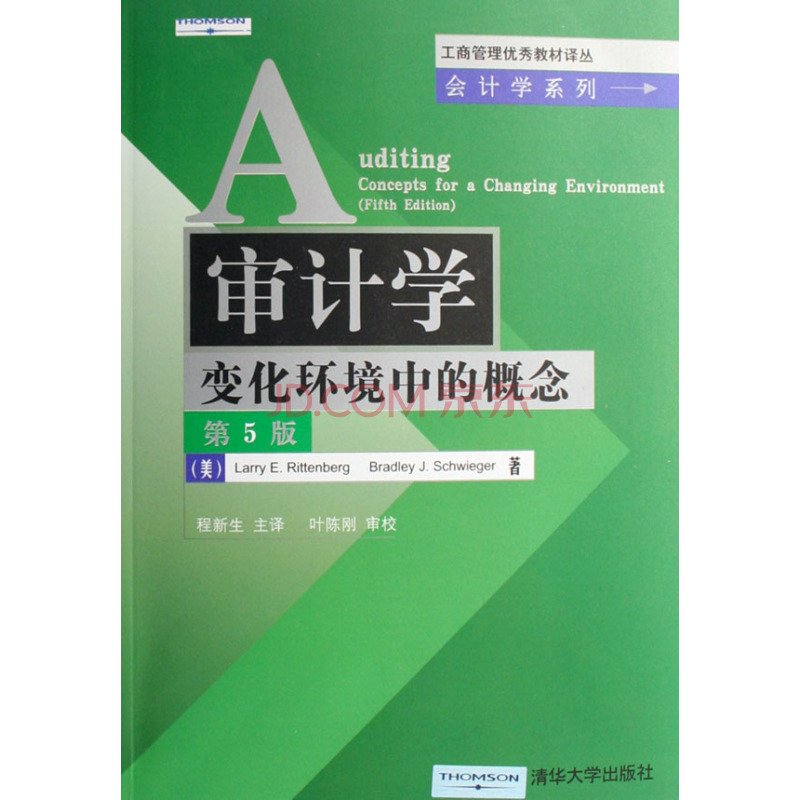圖書信息
出版社: 北京大學出版社; 第1版(英文影印版) (2003年1月1日)
外文書名: Auditing: Concepts for a Changing Environment
叢書名: 當代全美MBA經典教材書系
平裝: 855頁
正文語種: 簡體中文
開本: 16, 0開
ISBN: 7301059604
條形碼: 9787301059609
尺寸: 24.4 x 19.2 x 3.8 cm
重量: 1.3 Kg
作者簡介
作者:(美國)里坦恩伯格(L.E.Rittenberg) (美國)施維格(B.J.Schwieger) 叢書主編:張維迎
Karrt E.Rittenberg博士是美國University of Wisconsin-Madison會計和信息系統的Ernst & Young 教材,講授審計、計算機和業務審計。他曾經是內部審計師協會業務部的副主席和內部審計師研究基金的主席;美國會計學協會審計標準委員會的委員;美國會計師協會下屬計算機審計委員會、信息技術委員會的委員,審計委員會的藍帶委員。他擔任美國會計學協會的副主席和財力員。Rittenberg教授是註冊會計師、計算機工業協會會員和註冊內部審計師。他是5本課本和專著的聯合作者並發表過大量文章。
Bradley J.schwieger,工商管理博士和註冊會計師,ST.Cloud state university 的商務和會計系教授,美國會計學協會、美國會計師協會和明尼蘇達註冊會計量的審計成員。
內容簡介
本版更為強調的是理解
商業風險和新的商業環境。本書把在商業環境中發生的主要變化全部組織在一起,以現實中各種趨勢的發展作為第三版的編著基礎。本版繼續強調現實世界練習,其中包括利用網路的有意義的商業風險練習和現實世界的計算機化的練習。本書包含全世界使用最為廣泛的
審計軟體包IDEA,由CaseWare國際公司授權。IDEA提供給學生快速的學習經驗和競爭優勢。
媒體評論
出版者序言
2001年12月10日中國加入了世界貿易組織,從此,中國將進一步加大與世界各國的政治、
經濟、文化各方面的交流和合作,這一切都注定中岡將在未來世界經濟發展中書寫重要的一筆。
然而,中閩經濟的發展正面臨著前所未有的人才考驗,在許多領域都面臨著人才匱乏的現
象,杵別是廠解國際貿易規則、能夠適應國際競爭需要的國際管理人才,更是中國在未來國際競爭中所必需的人才。因此,制定和實施人才戰略,培養並造就大批優秀人才,是我們在新一輪國際競爭中贏得主動的關鍵。
工商管理碩士(MBA),1910年首創於美國哈佛大學,隨後MBA歷經百年風雨不斷完善,取得了令世人矚目的成績。現在,美國MBA教育已經力世界企業界所熟知,受到社會的廣泛承認和高度評價。中國的MBA教育雖起步較晚,但在過去10年裡,中國的MBA教育事業發展非常迅速,也取得了相當顯著的成績。現在國內已經有50多所高等院校可以授予MBA學位,為社會培養了3000多名MBA畢業生,並有在讀學員2萬多人。
二十一世紀初期,國內的MBA教育市場呈現一片繁榮景象,但繁榮的背後卻隱藏著種種亟待解決的問
題。其中很大一部分問題的成因是因為當前我國高校使用的教材內容陳舊,與國外名校的名牌
教材差距較大,在教學內容、體系上也缺乏與一流大學的溝通。為適應經濟全球化,國家教育管理部門曾要求各高校大力推廣使用外語講授公共課和專業課,特別是在我國加入WTO後急需的上百萬人才中,對MBA人員的需求更是占1/3之多,所以,大力開展雙語教學,適當引進和借鑑國外名牌大學的原版教材,是加快中國MBA教育步伐,使之走向國際化的一條捷徑。
二十一世紀初,國內市場上國外引進版教材也是新舊奸壞參差不齊,這就需要讀者進行仔細的甄別。
對於國外原版教材的使用,在這裡我們要提幾點看法。國外每年出版的教材多達幾萬種,如果不了解國外的教材市場,不了解國外原版教材的品質就可能找不到真正適合教學和學習的好的教材。對於不太了解外版教材的國內讀者來說,選擇教材要把握以下幾點,即:選擇國外最新出版的書;選擇名校、名作者的書;選擇再版多次並且非常流行的書。綜合以上幾點來看,目前國內市場上真正出新、出好、出精的MBA教材還是不多的。基於以上認識,北京大學出版社推出了《當代全美MBA經典教材書系(英文影印版)》,本套叢書的篩選正是本著以上提到的幾點原則。即:出新、出好、出精。經過北京大學及國內其他著名高校的知名學者的精心挑選,本套叢書匯集了美國管理學界各個學科領域專家的權威巨著,稱得上是一套優中選精的叢書。本套叢書現在已經推出了MBA主幹課程、會計專業、金融專業課程教程三個系列,共45個品種。以後,我們還將陸續推出更多專業的英文影印版書籍。
目錄
Chapter 1: Assurance Services
Introduction
A. Need for Assurance
Potential Bias in Providing Information
Remoteness of Users
Complexity
Need for Assurance Regarding Information and Operations
B. The Special Role of Financial Statement Audits
Auditing Defined
The Need for Unbiased Reporting
Requirements to Enter the Public Accounting Profession
C. The Providers of Assurance Services
The Public Accounting Profession
The Internal Audit Profession
Governmental Auditing Profession
D. Other Professional and Regulatory Organizations
The American Institute of Certified Public Accountants
State Boards of Accountancy
The Securities and Exchange Commission
The Institute of Internal Auditors
The U.S. General Accounting Office
The Court System
Summary
Significant Terms
eview Questions
Multiple-Choice Questions
Discussion and Research Questions
Cases
Chapter 2: Corporate Governance, Serving Client and Public Interests, and Audit Professionalism
A. Corporate Governance: Serving Client and Public Interests
Roles of Interested Parties
Who Is the Audit Client?
Audit Committees
Serving the Public's Interests
Assuring Quality
Framework for Quality
B. Maintaining Professionalism: Standards
Need for Professional Standards
Generally Accepted Auditing Standards
Standards for Other Audit Engagements
C. Maintaining Professionalism: Ethical Framework
Importance of Ethical Conduct
AICPA Code of Professional Conduct
Ethical Theories: Resolving Issues That Are Not Black or White 60 An Ethical Framework
D. Maintaining Professionalism: Ensuring Quality
Quality Control Standards and External Peer Reviews
Internal Peer Review Programs
Summary
Significant Terms
Review Questions
Multiple-Choice Questions
Discussion and Research Questions
Cases
Chapter 3: The Audit Process
A. Overview of Audit Process
Developing an Understanding with the Client
The Audit Process
B. Materiality and Audit Risk
Overall Materiality versus Individual Account Materiality
Materiality Approaches
Risk of Material Misstatement
Risk Concepts
The Profession's Audit Risk Model: Practice Implications
Illustration of the Audit Risk Model
Limitations of the Audit Risk Model
C. Management Assertions
Financial Statement Assertions
Assertions for Other Assurance Services
D. Audit Evidence and Procedures
Relevance
Persuasiveness
Sufficiency
Relationship Among Audit Procedures and Assertions
Examples of Audit Programs
Summary
Significant Terms
Review Questions
Multiple-Choice Questions
Discussion and Research Questions
Chapter 4: Understanding Business Risk: A Framework for Audit Planning
Chapter 5: Evaluating the Integrity and Effectiveness of the Client's Control Systems
Chapter 6: Computer-Based Processing: Developing an Audit Assessment Approach
Chapter 7: Direct Tests of Account Balances
Chapter 8: Auditing Computerized Information Systems
A. Computer Audit Took to Test Computer Processing
Overview of a Comprehensive Approach to Computerized Data Processing

